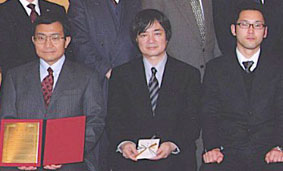Associate Professor IWASHITA, Yoshihisa “High Resolution Optical Surface Inspection for Superconducting Accelerating Cavity”
|
Associate Professor IWASHITA, Yoshihisa (Advanced Research Center for Beam Science, Division of Particle Beam Science)
“High Resolution Optical Surface Inspection for Superconducting Accelerating Cavity” |

Associate Professor IWASHITA, Yoshihisa (left) |
|
Physicists have been trying to understand the fundamental components of the universe, and explain the origin of mass. The global particle physics community agrees that a precision machine “the proposed International Linear Collider (ILC)”, will answer these questions. The ILC will complement the Large Hadron Collider, a proton-proton collider at the European Center for Nuclear Research (CERN) in Geneva, Switzerland, together unlocking some of the deepest mysteries in the universe. With LHC discoveries pointing the way, the ILC ”a true precision machine” will provide the missing pieces of the puzzle. Although LHC, an approximate circle 27 km in circumference, has small curvature, it still suffers from energy loss by synchrotron radiation. Therefore, ILC accelerates the beams in straight linear accelerators. In order to make the accelerated energy high with a limited length, the accelerating gradient should be as high as possible. ILC uses superconducting accelerator tubes made of Nb, which afford high gradients while reducing the RF power loss drastically, instead of conventional copper based tubes. |
|
|
The superconducting accelerator tubes are somewhat delicate since they should be kept at very low temperature. Because the RF current only flows on the very surface of the Nb surface, the surface treatment is very important to achieve their performance. In spite of this importance, the shape of the cavity prevents an easy inspection and only simple observations have been done, such as by a (gastro)fiberscope, which is not high resolution. Among some speculated causes of cavity performance limitations, we focused on surface defects that may cause thermal break down and developed a high-resolution camera to find them. |
|
|
The inner surfaces are finished with electrochemical polishing, and become very smooth, making the inner surface a good mirror. The lighting method for camera inspection is the key issue for successful observation. Thus, we adopted a electroluminescence sheet for that purpose. The developed camera directly revealed the location and gave details of previously undiscovered defects on the inner surface where other measuring techniques could only locate the suspicious area. Since no one expected such defects on the surface, it gave news in the world. This camera system will help to improve the performance or yield of the production of the superconducting cavities. It has been improved for further resolution and functionality. Superconducting accelerating tubes also spread its application to projects such as European XFEL and so on. |
|
 Institute for Chemical Research, Kyoto University
Institute for Chemical Research, Kyoto University International Joint Usage Research Center
International Joint Usage Research Center